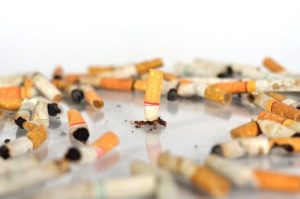
Tobacco use negatively impacts our physical and mental health. This is particularly true for college students, who are already facing major health challenges such as stress. Tobacco use has also been connected to poor academic performance, high-risk drinking behavior, illicit drug use and high-risk sexual behavior.
How does cigarette smoke affect the body?
Many toxic chemicals used to make cigarettes are released into the surrounding air when the cigarette burns. When you smoke a cigarette, you inhale nicotine as well as more than 400 chemicals being burned. Among these chemicals are mercury, lead and arsenic, which are known cancer-causing agents. Other lethal ingredients in cigarette smoke include ammonia, acetone, formaldehyde, and carbon monoxide.
Nicotine is an addictive component that reaches the brain within 10 seconds of an inhalation. Nicotine works like cocaine or heroin by activating the portions of the brain that control the feelings of pleasure, including the release of dopamine. Because the effect is short-lived, the person craves another cigarette.
You either smoke or you don’t. Some students smoke occasionally but do not consider themselves smokers. If you “only” smoke when you go out or study for exams, consider that even occasional nicotine use causes “pairing” in the brain. Once your brain starts pairing up events like studying with smoking or partying with smoking, it becomes harder to do one without the other. An estimated 50% of occasional smokers will go on to smoke full-time for 6-10 years.
How does smokeless tobacco affect your body?
Besides nicotine, many toxic chemicals are used to make smokeless tobacco. Among these chemicals are lead, arsenic and 26 more known carcinogens. Other lethal ingredients include cadmium, cyanide, polonium, formaldehyde, sand and grit.
Chewing tobacco actually contains more nicotine than cigarettes. Nicotine works like cocaine or heroin by activating the portions of the brain that control the feelings of pleasure, including the release of dopamine. Even occasional nicotine use causes “pairing” in the brain. Once your brain starts pairing up events like studying or partying with chewing tobacco, it becomes harder to do one without the other.
- Some of the effects of smokeless tobacco include:
- Cancer of the lips, gums, tongue, cheeks, pharynx, stomach and pancreas
- Heart disease
- Leukoplakia (white sores in the mouth that can lead to cancer)
- Gum recession, or peeling back of gums
- Bone loss around the teeth
- Abrasion of teeth
- Bad breath
How to recognize a problem
Some students think that there is no problem with their tobacco use. Answering the following questions can help you determine whether you or a loved one has a problem with tobacco:
- Do you crave cigarettes?
- Do you smoke without thinking about it?
- Do you rationalize or justify smoking?
- Do you choose friends, jobs or activities that permit you to smoke?
- Do you avoid those who do not?
- Do you continue using tobacco despite good reasons for quitting?
If you think that you or someone you know might have a problem with tobacco use, it is important to see a doctor or other health care provider and make a plan to quit.
All services at Habif Health and Wellness Center are confidential: appointments with a substance abuse specialist can be anonymous. Inquiries for referral may be for yourself or someone else.
Are you ready to quit?
- Stop smoking the night before your chosen day: When you wake up the next morning, you will have an 8-hour head start to being smoke-free!
- Stay active: Try walking, exercising or doing other activities or hobbies.
- Hydrate: drink lots of water and/or low-sugar fruit juices.
- Medications: You are more likely to succeed with pharmaceutical therapy plus behavioral counseling.
- Classes and resources: Start or continue attending a smoking cessation class, follow a self-help plan and/or use computer resources. Call your support system or a quit line when you feel tempted.
- Stay clear: Avoid high-risk situations where you feel the urge to smoke.
- Reduce or avoid alcohol and caffeine: Alcohol clouds judgment and can make it easier to relapse and smoke. Alcohol or caffeine may also be linked to smoking for some people and it’s important to break this connection.
- Put the three “A’s” in motion:
- Avoid. Certain people and places can tempt you to smoke. Stay away for now. Later on, you’ll be able to cope.
- Alter. Switch to soft drinks or water instead of coffee or alcohol. Use oral substitutions like sugarless gum, hard candy or sunflower seeds. Take a walk when you used to take a smoke break. Take a different route to school or work.
- Active. Initiate or maintain physical activity. Try activities that involve using your hands to replace the smoking motion (i.e., crossword puzzles, writing/journaling, playing catch, taking a tennis lesson, etc.)
More smoking help
- The Bacchus Network is an initiative to promote campus health.
- Tobacco Free Generation Campus Initiative is a program dedicated to creating tobacco-free generations from the American Cancer Society.
- The American Lung Association offers a free smoking cessation program online.
- Join others in their attempt to quit smoking at QuitNet.
- There is more information on smoking cessation at FamilyDoctor.